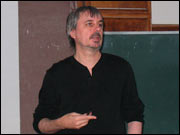|
|
Заседания Московского математического общества
13 марта 2012 г. 18:30, г. Москва, ГЗ МГУ, аудитория 16-10
|
|
|
|
|
|
|
Persistence, cell segregation, and Alexander duality for functions
H. Edelsbrunner |
| Количество просмотров: |
| Эта страница: | 297 |

 Фотогалерея Фотогалерея
|
Аннотация:
Part 1. Persistent homology is a recent extension of the classical theory of homology in algebraic topology. Assuming a filtered sequence of spaces, it quantifies the interval along which a homology class is alive.
This extension is critically important in applications of homology to shapes that arise in nature.
Part 2. Cells in the embryo rapidly progress, moving around, dividing, getting into formation. We consider a particular segregation process within early zebrafish embryos, which can be observed, in 3D, using
multi-colored fluorescent markers. We present a topological approach toward a detailed phenotypical characterization of the process, which we model as a shape in 4-dimension space-time. (Joint work with Carl-Philip Heisenberg, Michael Kerber, and Gabby Krens.)
Part 3. The analysis focuses on the time-function on the space-time shape. It motivates a generalization of the classic Alexander Duality from spaces to functions. Specifically, consider a decomposition of the $(n+1)$-sphere into spaces $U$ and $V$ whose intersection is an $n$-manifold, $M$. Alexander duality relates the homology of $U$ and $V$, and combined with the Mayer-Vietoris exact sequence, it relates the homology of
$M$ and $U$. This talk presents extensions of these relations to real-valued functions.
(Joint work with Michael Kerber.)
|
|



 Обратная связь:
Обратная связь: Пользовательское соглашение
Пользовательское соглашение
 Регистрация посетителей портала
Регистрация посетителей портала Логотипы
Логотипы